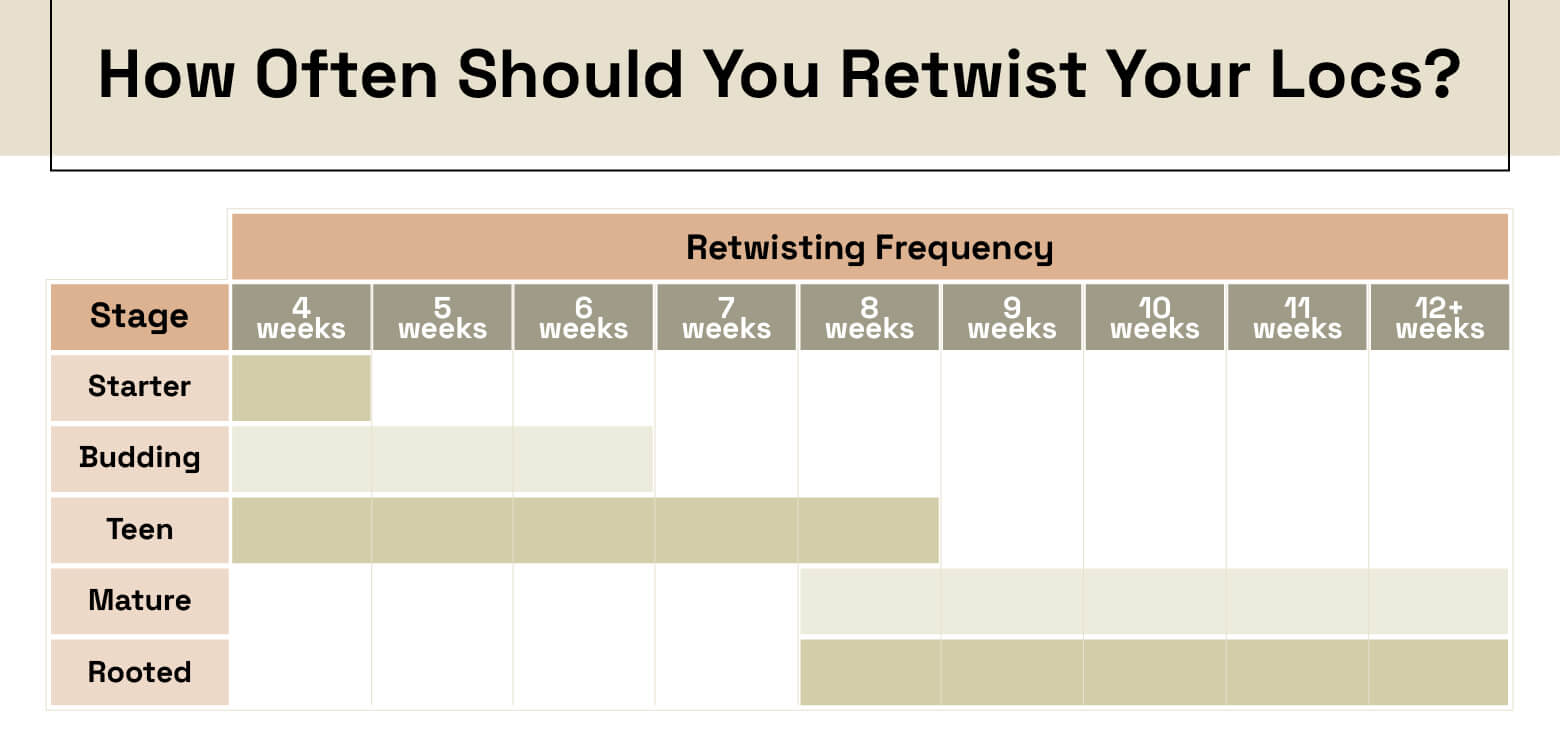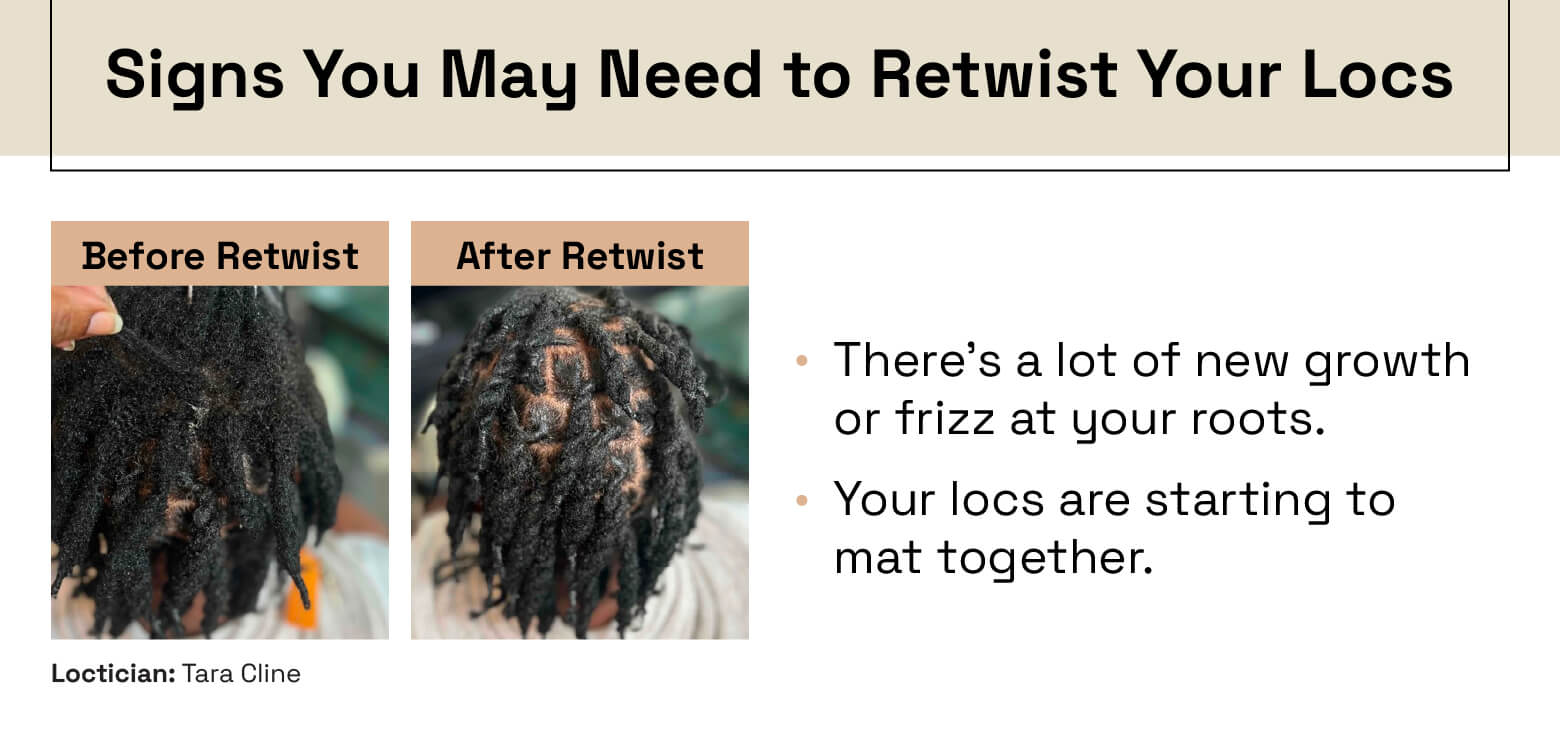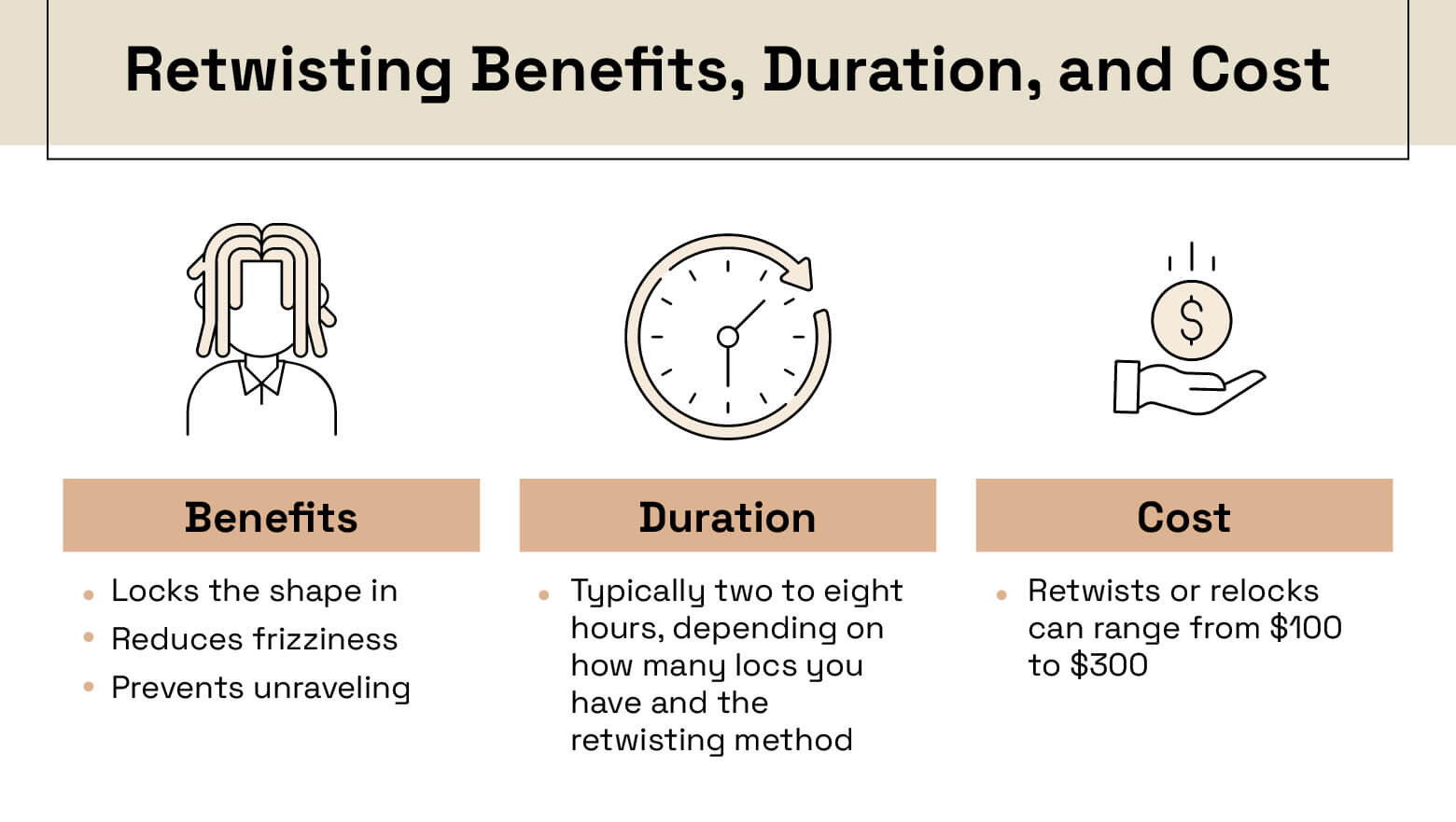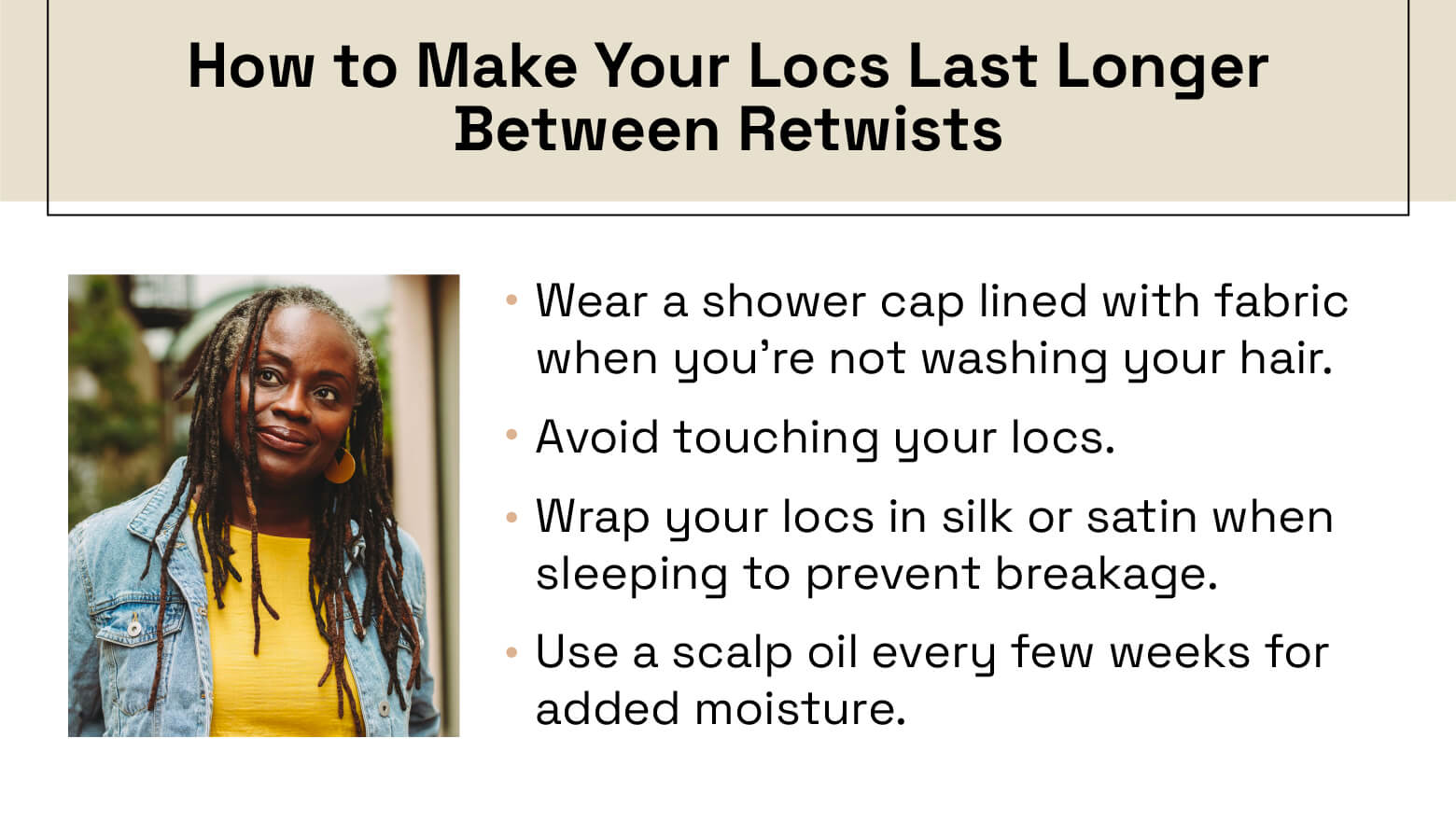As a general rule of thumb, you should retwist your locs every four to six weeks. However, this may be shorter or longer depending on multiple factors such as hair texture, loc phase, and lifestyle.
The purpose of retwisting your locs — whether you have interlocking locs or palm roll them — is to shape and train the hair into the look you want over time. Retwisting your locs too frequently can lead to damage, causing thinning and breakage. On the other hand, not retwisting enough may cause your locs to mat together and lose the desired shape.
This post covers how often to retwist locs based on loc stage, what to do if your locs start unraveling, and how to keep locs looking good longer.
How Often You Should Retwist Your Locs Based on Your Loc Phase
In the starter phase, you should retwist your locs every four weeks and may even retwist every two to three weeks for the first four to six weeks. After that, retwist every four to six weeks in the budding phase, four to six weeks in the teen stage, and eight to twelve-plus weeks during the mature and rooted phases.
Remember that the suggested frequency of retwisting is just a guideline. Factors such as your hair texture, if you have thin, fine or coarse hair strands, how you maintain your hair, and your lifestyle will all impact how often you’ll need to retwist.
The following chart provides a general guideline for when to get your locs retwisted based on the loc stage you’re in:

Typically, if you have thinner hair, you may need more frequent retwists than if you have thicker, coarser hair.
Starter Phase
The starter phase is the beginner stage and can last three to six months. How frequently you should retwist your locs during this phase depends on how thin or coarse your hair is. Typically, you’ll want to retwist them every four weeks during the starter phase, though you may want to retwist every two to three weeks the first month or month and a half.
Overtwisting starter locs can lead to damaging, thinning, and breakage, so assess your hair care needs to avoid retwisting too frequently.
Budding Phase
This phase comes after the starter phase and lasts six to twelve months. Try to establish a regular retwisting routine in this phase, retwisting every four to six weeks as you see fit with your hair type and texture. You’ll know if you’re retwisting too frequently if you start to see hair damage.
Teen Phase
The teen phase follows the budding phase, coming about twelve to eighteen months into your loc journey. The locs will begin taking on their shape at this stage. Make sure to follow your regular loc maintenance schedule, retwisting about every four to eight weeks.
Mature Phase
This phase can last anywhere from fifteen to eighteen months or about one to two years. While you won’t need to retwist mature locs to hold their shape, you may want to retwist every eight to twelve-plus weeks to reduce frizz.
Rooted Phase
Also known as the adult stage, this is the final phase of the loc journey. The rooted phase occurs after eighteen to twenty-one months or up to two years after the first time you get your locs twisted. As in the mature phase, you can retwist your locs every eight to twelve-plus weeks to cut down on frizzy hair.
Remember, a retwisting schedule is highly personal. You may have to experiment with what works best for you and your hair goals.

How Do You Know When to Retwist Your Locs?
You may want to retwist locs when there’s a lot of new growth or frizz at your roots. A good time to retwist locs is after wash day, though this will depend on your wash schedule. If your locs are starting to marry or mat together, it may be time for a retwist. However, remember that you can groom and separate your locs without retwisting them.
The exception is if you’re free forming your locs, or letting them form into locs on their own over time. Freeform dreadlocks are thicker than traditional locs, and you generally cannot see the hairlines. A variety of freeform dreadlocks and semi-freeform dreads involve a palm-rolling technique and occasional retwisting every four to six months or more.
What Happens If You Don’t Retwist Your Locs?
Not retwisting can be damaging to your locs, potentially causing the following problems.
- The roots become thin.
- Locs start sticking together.
- They can join in odd places, leaving holes.
- Locs break off at the ends.
- They snap at the roots.
- You have two textures on your head: one at the roots, another at the ends.
- You can develop hair loss from the weight of the locs on thin roots.
Additionally, not getting retwists may affect your hair texture. Depending on your hair type, it may benefit from less frequent retwists. If you have soft, fine, or curly hair, however, not retwisting your locs can cause your hair to lose its thickness, and you may notice your hair breaking as it starts to grow away from the locs.
What to Do If Your Locs Start Unraveling?
Retwisting your locs on the appropriate schedule for your hair can help prevent unraveling. If you do notice your locs coming undone, however, you can try the following techniques:
- Retwist strands that unraveled. If your locs unravel from the bottom, you can recoil them or retwist them with two-strand twists to get the locs back into shape.
- Use a small rubber band, elastic hair tie, or clip to stop locs from unraveling. You can either place it on the bottom of an individual loc or secure a few locs together to seal the twist overnight.
- Put a light hair gel, aloe vera gel, or even water from a spray bottle to seal the locs at the bottom. Wetting the ends can increase the coil in curly hair, helping it retwist naturally. Avoid drenching your locs to prevent hair product buildup or inadvertently making the unraveling worse.
- Protect your hair from root to tip by wrapping or tying up your hair with a scarf or bonnet.
- Wash your hair less frequently to prevent unraveling.

What Are the Benefits of Retwisting Your Locs?
No matter what your natural hair texture or which loc hairstyle you hope to achieve, retwisting your locs has its advantages. The benefits of retwisting your locs include the following:
- Locking the shape in: Retwisting trains your hair for the ultimate shape you want. In the later stages of your loc journey, you should notice the locs staying in formation longer than at the beginning.
- Reducing frizziness: With new hair growth, the roots of your locs will begin to loosen and can lead to frizz, tangles, and breakage. Retwisting your locs can help prevent this from happening.
- Preventing unraveling locs: Of course, one of the main purposes of retwisting is to stop your locs from unraveling and undoing all the work that came before.
- Keeping your look neat and tidy: Since retwisting locs keeps their shape, prevents loose hair, and cuts down on damage, it can help keep your style looking good.
How Long Does Retwisting Take?
Retwisting can take anywhere from two to eight hours, but may be less or more depending on how many locs you have. While you can twist your own locs in a pinch, getting it done by an experienced loctician can save you a lot of work and make sure it’s done right. To schedule your retwist with a loc technician in your area, you can book an appointment through StyleSeat.
How Much Does Retwisting Cost?
Retwists or relocks can range anywhere from $100 to $300, depending on your hair length, hair texture, and desired grid pattern. It may cost $50 an hour depending on your location and loctician. You can find a loctician near you and see their prices on StyleSeat.

Tips to Make Your Locs Last Longer
To keep your locs in formation and prevent them from matting together, keep the following tips in mind:
- Wear a shower cap when you’re not shampooing. While a light spray of water may help coiling, drenching them in the shower can loosen twists. Instead of an all-plastic cap, use one with material on the inside to prevent any steam from frizzing up your locs.
- Avoid touching your locs. Playing with your twists, scratching your head too deeply, or otherwise touching your hair can cause your locs to unravel.
- Wrap your locs in a silk bonnet or satin scarf at night. Friction from tossing and turning as you sleep can damage your hair.
- Use a scalp oil every few weeks for added moisture. While you’ll want to avoid applying too much product to your hair, massaging your scalp with a lightweight scalp oil every few weeks can help soothe skin and hydrate hair follicles.
- Retwist when needed. Sticking to your retwist schedule can help your locs last longer.
How to Prepare Your Locs for Retwisting
Depending on your personal preference, you can retwist your own locs or have it done by a hairstylist experienced in locs. If you don’t have the desire or experience needed for DIY locs, make an appointment with a local loc technician. You’ll want clean locs going into the appointment, so wash your hair beforehand or ask if the salon will provide a wash.
Ready to Book Your Next Retwist Appointment?
Maintaining a regular retwist schedule is the foundation of healthy, long-lasting locs. Between retwists, you can take other steps to keep your locs in formation such as shampooing less frequently, sleeping in a smooth bonnet, and avoiding touching your hair too much. When it’s time to get your locs retwisted by a professional, find a loctician in your area with the help of StyleSeat.






